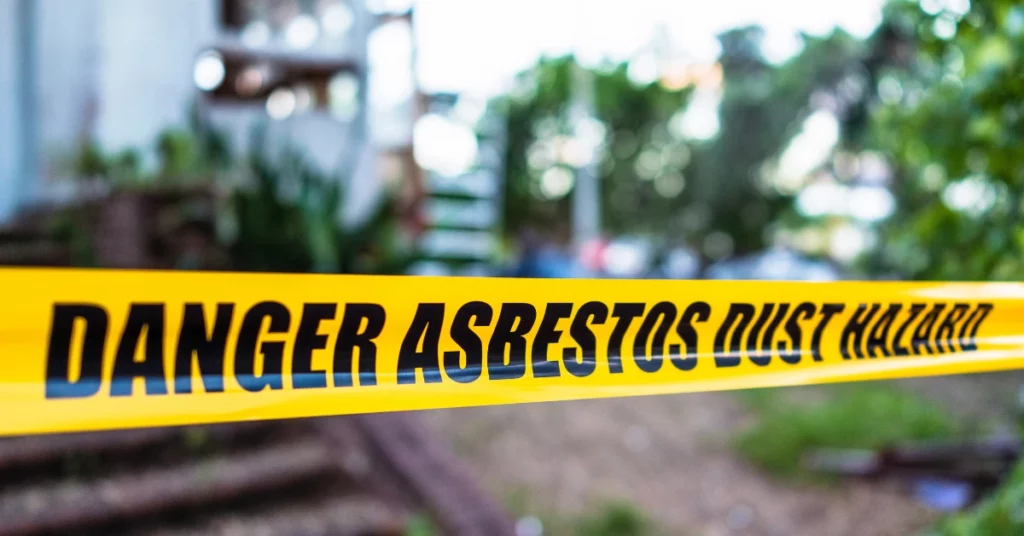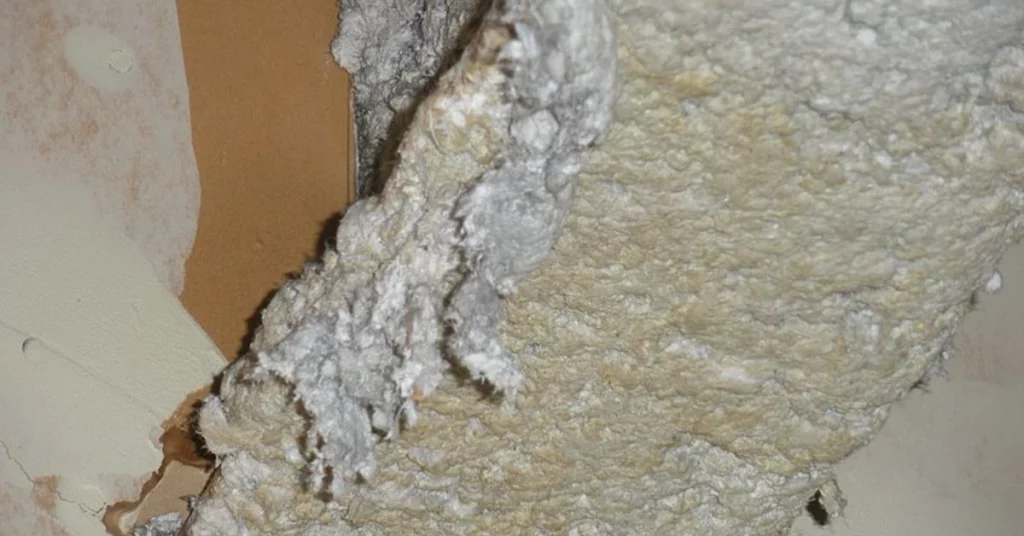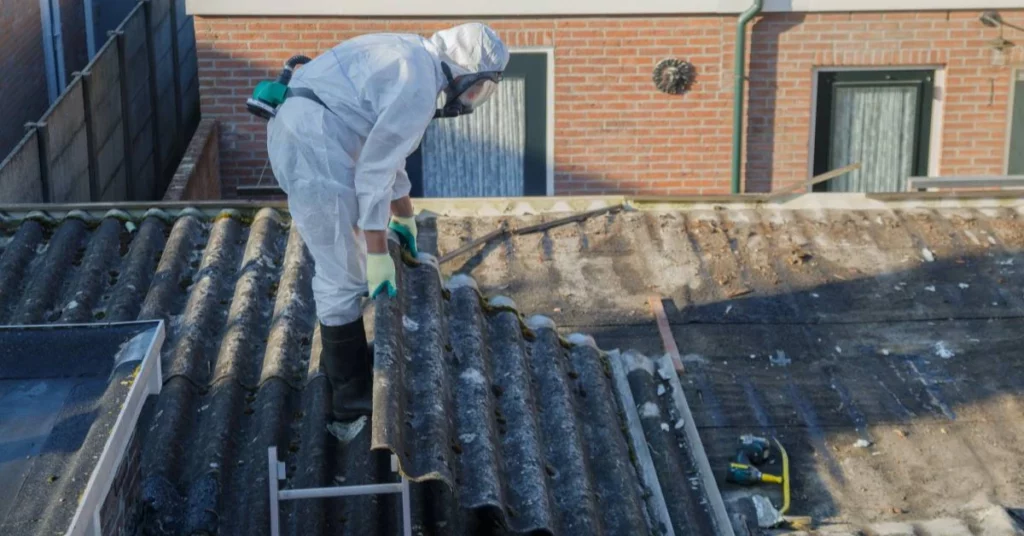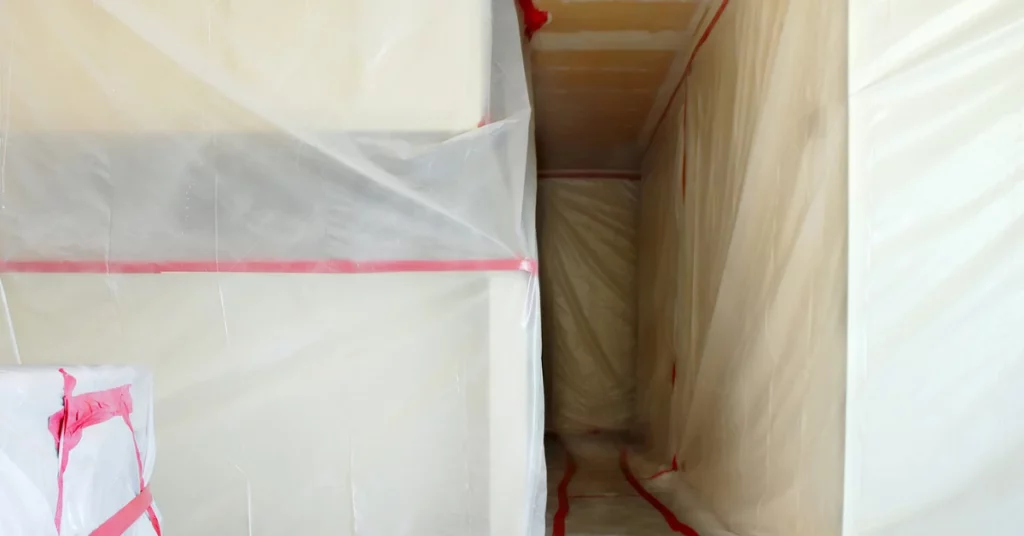What is Asbestos Exposure?
Asbestos exposure occurs when asbestos fibers are released into the air and inhaled or ingested. These fibers can become airborne during the disturbance of asbestos-containing materials (ACMs) found in older buildings, insulation, or industrial products. Exposure to asbestos typically happens in environments where ACMs are present, such as construction sites, shipyards, and older homes. The small, durable fibers can remain in the air for long periods, posing a significant health risk to anyone who breathes them in.
How Does Asbestos Exposure Occur?
Asbestos exposure occurs through various scenarios where asbestos-containing materials are disturbed. Occupational exposure is the most common, particularly in industries like construction, demolition, and shipbuilding. Workers in these fields may inhale asbestos fibers during tasks like drilling, cutting, or sanding materials that contain asbestos. Environmental exposure can happen when asbestos fibers are released into the air from natural deposits or from industrial processes that involve asbestos. Additionally, asbestos exposure can occur in homes when older asbestos-containing products, such as insulation or floor tiles, deteriorate or are disturbed during renovations.
What Are the Health Risks Associated with Asbestos Exposure?

Asbestos exposure is linked to several serious health risks, primarily due to the fibers’ ability to penetrate deep into the lungs when inhaled. Mesothelioma, a rare and aggressive cancer, is directly caused by asbestos exposure. Lung cancer is also strongly associated with asbestos, especially among smokers who have been exposed to asbestos. Asbestosis, a chronic lung disease, results from prolonged exposure to asbestos and causes scarring of lung tissue, leading to breathing difficulties. The latency period for these diseases can be long, often taking decades to develop after the initial exposure.
What Diseases Are Caused by Asbestos Exposure?
Asbestos exposure causes diseases such as mesothelioma, lung cancer, and asbestosis. Mesothelioma is a cancer that affects the lining of the lungs, abdomen, or heart and is almost exclusively linked to asbestos exposure. Lung cancer can develop in those exposed to asbestos, particularly in individuals who also smoke. Asbestosis is a non-cancerous, yet serious, lung condition that results from inhaling asbestos fibers, leading to chronic lung tissue scarring and impaired breathing. These conditions are often fatal, highlighting the severe consequences of asbestos exposure.
How Does Asbestos Exposure Affect the Lungs?
Asbestos fibers affect the lungs by becoming lodged in lung tissue after being inhaled. Over time, these fibers cause inflammation and scarring, which can lead to the development of asbestosis or lung cancer. Asbestosis develops when scar tissue forms in the lungs, leading to stiffness and difficulty in breathing. Lung cancer from asbestos exposure typically occurs after long-term inhalation of asbestos fibers, which damage lung cells and lead to cancerous growths. The lungs’ inability to expel these durable fibers means that even low levels of exposure can have significant health consequences over time.
What Are the Symptoms of Asbestos Exposure?
The symptoms of asbestos exposure often do not appear until decades after the initial exposure, making early detection difficult. Common symptoms associated with asbestos-related diseases include persistent coughing, shortness of breath, chest pain, and unexplained weight loss. These symptoms are often indicative of serious conditions such as asbestosis, lung cancer, or mesothelioma. Asbestosis symptoms typically involve chronic cough and difficulty breathing, while mesothelioma may present with chest pain and fluid buildup in the lungs or abdomen. Early recognition of these symptoms is crucial for timely medical intervention.
What are the Early Signs of Asbestos Exposure?
Early signs of asbestos exposure can include subtle respiratory issues that gradually worsen over time. Persistent dry cough, shortness of breath during physical activity, and chest discomfort are among the first indications that asbestos fibers have caused lung damage. Fatigue and general weakness may also occur as the body struggles to cope with the diminished lung capacity. Early detection is challenging due to the long latency period of asbestos-related diseases, but these initial symptoms should prompt immediate medical consultation.
When to See a Doctor After Asbestos Exposure?
If you suspect you’ve been exposed to asbestos, it is essential to see a doctor even if you are not currently experiencing symptoms. Asbestos-related diseases have a long latency period, often taking 20 to 50 years to develop. Early medical consultation can help monitor your health and detect any potential issues before they progress. Routine screenings, such as chest X-rays or lung function tests, can identify early signs of lung disease caused by asbestos. It’s particularly important to seek medical advice if you have a history of occupational exposure or if you live in a home with asbestos-containing materials.
How Can Asbestos Exposure Be Prevented?
Preventing asbestos exposure involves taking proactive steps to avoid contact with asbestos-containing materials. In homes, this includes identifying and managing asbestos in older building materials, such as insulation, floor tiles, and roofing. Professional inspection by certified asbestos inspectors can confirm the presence of asbestos, allowing for safe removal or encapsulation. In the workplace, especially in construction and manufacturing, employers must enforce strict safety protocols, including the use of personal protective equipment (PPE) and proper training on handling asbestos. Regular monitoring and air quality testing can further reduce the risk of exposure.
What To Do if You Suspect Asbestos in Your Home
If you suspect asbestos in your home, it is important to avoid disturbing any materials that might contain asbestos fibers. The first step is to arrange for a professional asbestos inspection. Certified inspectors can safely assess the situation and recommend the best course of action, whether that involves removal or encapsulation. Do not attempt to remove asbestos yourself, as improper handling can release dangerous fibers into the air. Instead, hire a licensed asbestos removal contractor who can ensure the material is handled and disposed of in accordance with safety regulations. Following these steps will help protect your household from the health risks associated with asbestos exposure.

Why Is Regular Monitoring Important After Asbestos Exposure?
Regular health monitoring is important for individuals who have been exposed to asbestos, even if they do not currently exhibit symptoms. Asbestos-related diseases often have long latency periods, so ongoing medical surveillance can help detect early signs of illness, allowing for timely intervention. Monitoring typically involves periodic chest X-rays, lung function tests, and other imaging studies to assess the condition of the lungs. Regular check-ups with a healthcare provider who understands asbestos-related risks can also lead to early diagnosis and better management of conditions like asbestosis or mesothelioma.
What to Expect During Medical Monitoring for Asbestos Exposure?
During medical monitoring for asbestos exposure, individuals can expect a series of tests designed to detect early signs of asbestos-related diseases. Chest X-rays are commonly used to identify any scarring or abnormalities in the lungs that might indicate asbestosis or lung cancer. Pulmonary function tests (PFTs) measure how well the lungs are working by assessing airflow and lung capacity, helping to detect any early impairment caused by asbestos fibers. In some cases, CT scans may be used for a more detailed look at the lungs, especially if initial tests show concerning results. These monitoring efforts are critical for early detection and management of asbestos-related health issues.
What are the Legal Rights and Compensation for Asbestos Exposure Victims ?
Victims of asbestos exposure have legal rights to seek compensation for the health consequences they suffer due to negligent exposure. This compensation can cover medical expenses, lost wages, pain and suffering, and more. In the United States, many workers exposed to asbestos are eligible for workers’ compensation, which provides financial support for work-related illnesses. Additionally, victims may be able to file lawsuits against manufacturers of asbestos-containing products or employers who failed to provide adequate protection. Asbestos trust funds have also been established by bankrupt asbestos companies to compensate victims. Understanding your legal options and consulting with an experienced attorney can help secure the compensation you deserve.
How to File a Claim for Asbestos Exposure
Filing a claim for asbestos exposure involves several important steps. The first step is to gather all relevant medical documentation that confirms an asbestos-related diagnosis, such as mesothelioma or asbestosis. Next, it’s essential to consult with a specialized attorney who can guide you through the legal process, whether you’re pursuing a workers’ compensation claim, a personal injury lawsuit, or a claim against an asbestos trust fund. The legal process typically requires proving that the exposure occurred as a result of negligence, which might involve gathering evidence of unsafe working conditions or defective products. The attorney will help you navigate these complexities, ensuring that all deadlines are met and that your case is presented effectively.
What Types of Compensation Are Available for Asbestos Exposure?
Compensation for asbestos exposure is available through various channels, depending on the nature and circumstances of the exposure. Workers’ compensation provides benefits to those exposed to asbestos in the workplace, covering medical expenses, rehabilitation costs, and a portion of lost wages. In cases where exposure was due to negligence by a company, individuals might be eligible to file a personal injury lawsuit, which can result in compensation for medical bills, lost income, pain and suffering, and punitive damages. Additionally, asbestos trust funds have been established by bankrupt asbestos companies to compensate victims. These trust funds are specifically set aside to provide financial relief to those diagnosed with asbestos-related diseases, even years after the exposure occurred.
What to Expect During a Compensation Claim Process
The compensation claim process for asbestos exposure involves several key steps. Initially, you will need to gather extensive documentation, including medical records that confirm an asbestos-related diagnosis and employment records that demonstrate where and how the exposure occurred. Working with an attorney who specializes in asbestos cases is important, as they will handle the legal complexities and file the necessary paperwork. The process may involve negotiations for a settlement or, in some cases, going to trial if a settlement cannot be reached. Claimants should be prepared for the process to take time, as asbestos cases can be complex and require thorough investigation.
Resources and Support for Those Affected by Asbestos Exposure
Support for those affected by asbestos exposure is available through a variety of resources, including medical, legal, and community organizations. The American Lung Association offers information and support for individuals dealing with lung diseases related to asbestos exposure. The Mesothelioma Applied Research Foundation provides resources specifically for mesothelioma patients, including access to clinical trials and support groups. Legal assistance can be found through organizations like The Asbestos Disease Awareness Organization (ADAO), which also offers education and advocacy for asbestos victims. Additionally, local health departments in Florida and other states often provide resources and referrals for those needing medical or legal support related to asbestos exposure.
National and Florida Support Organizations for Asbestos Exposure
The Environmental Protection Agency (EPA) offers guidelines and resources for managing asbestos in homes and workplaces, while The Florida Department of Health provides information on asbestos exposure risks and health monitoring programs. The Asbestos Disease Awareness Organization (ADAO), a national group, advocates for a global ban on asbestos and provides education and support for victims and their families. Locally, The Florida Mesothelioma Victims Center offers specialized support and resources for those diagnosed with mesothelioma in the state, including assistance with finding top medical treatment and legal advice.
How to Access Support Services for Asbestos Exposure
Accessing support services for asbestos exposure involves reaching out to the appropriate organizations that specialize in asbestos-related issues. Start by contacting national organizations such as The Mesothelioma Applied Research Foundation for medical support and information on clinical trials. For legal advice and assistance with compensation claims, connect with specialized law firms that handle asbestos cases or reach out to the Asbestos Disease Awareness Organization (ADAO) for resources. In Florida, the Department of Health and local health departments can provide guidance on health monitoring and exposure prevention. These organizations can help navigate the challenges of dealing with asbestos exposure, from securing medical care to pursuing legal claims.







